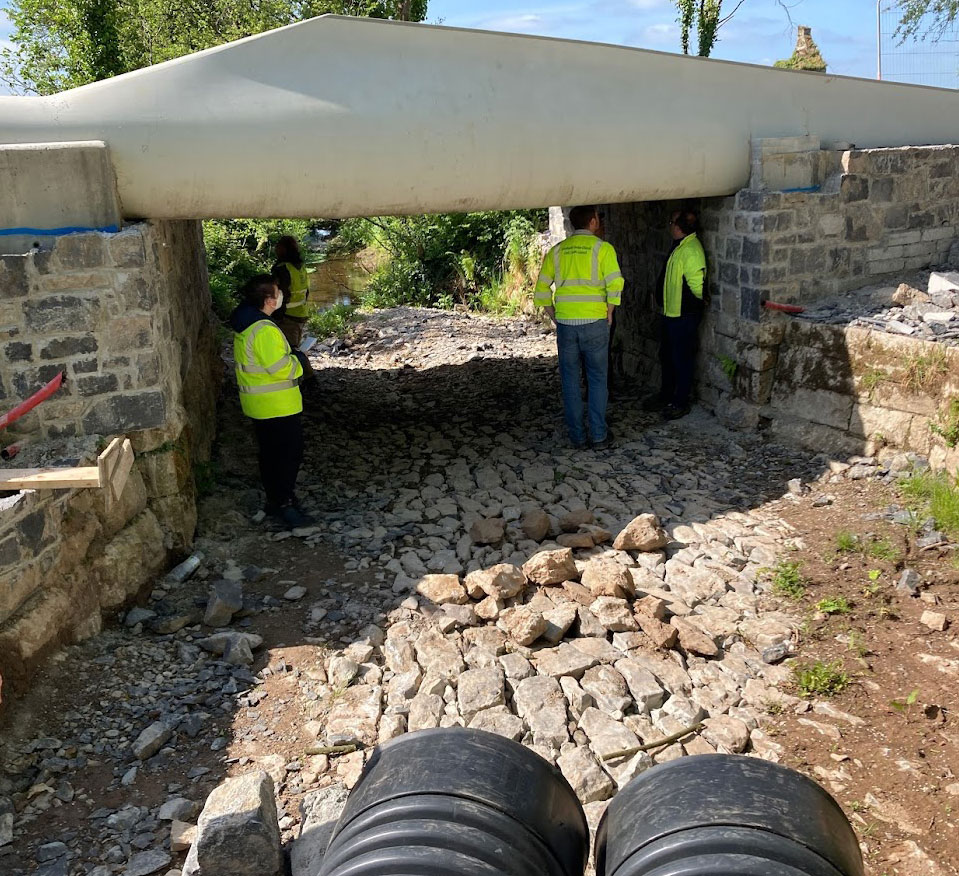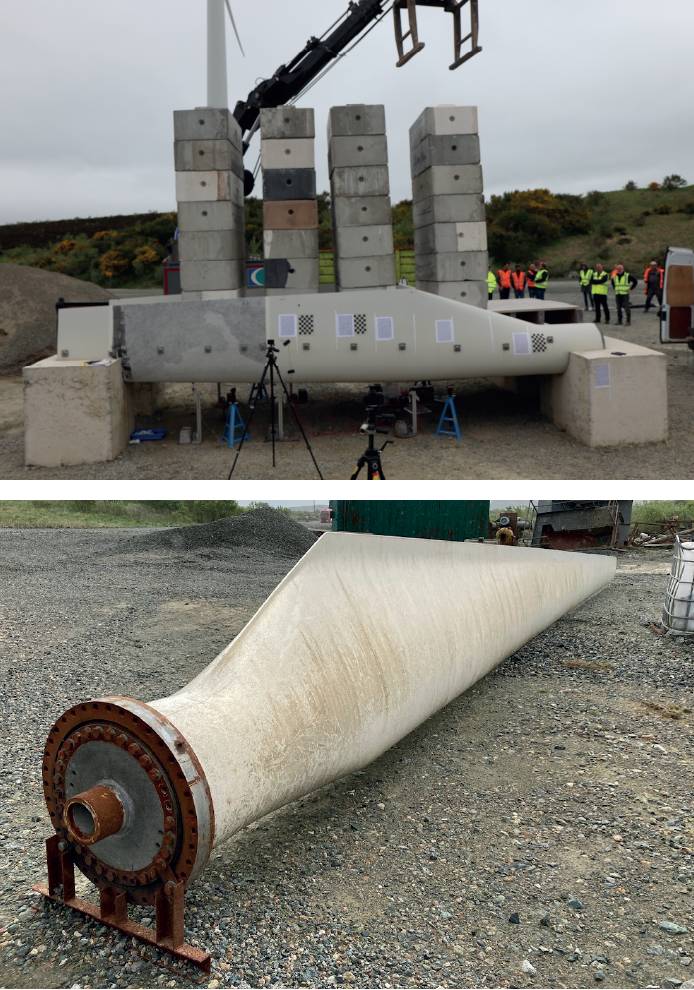Innovative Thinking | Blade bridges
Cutting edges
A transatlantic research network is finding ways to repurpose decommissioned wind turbine blades as footbridges, writes Belinda Smart.
As the government scales up wind farm development, the challenge of disposing of turbine blades when they reach the end of their lives is gaining urgency.
Turbine blades are primarily made of glass fibre reinforced polymer (GFRP) composite materials. They are non-biodegradable and designed for a service life of 20 to 25 years.
 Draperstown Bladebridge was tested by loading it with 34 blocks weighing 1,100kg in May University of Cambridge researchers estimate a cumulative total of 43M.t of waste blades will be generated worldwide by 2050. To date, the wind energy industry has favoured low-cost disposal including landfill and incineration, but these methods are increasingly seen as environmentally unacceptable.
Draperstown Bladebridge was tested by loading it with 34 blocks weighing 1,100kg in May University of Cambridge researchers estimate a cumulative total of 43M.t of waste blades will be generated worldwide by 2050. To date, the wind energy industry has favoured low-cost disposal including landfill and incineration, but these methods are increasingly seen as environmentally unacceptable.
As a result, it is unsurprising that efforts to repurpose the blades are underway. The Re-Wind Network is a partnership between Georgia Institute of Technology and City University of New York in the United States, Queen’s University Belfast in Northern Ireland and University College Cork in the Irish Republic. It is looking at the possibilities for urban structures to be built using end-of-life blades.
Potential uses include bus shelters, barriers, street furniture and transmission or telecommunications towers. Recently Re-Wind has also focused on using them in footbridges, known as BladeBridges.
Georgia Institute of Technology research engineer Larry Bank says the research team pursued the bridge concept as it “checked boxes in that bridges are supported by long horizontal girders and these blades meet the criteria of long, linear structural systems, which would be good for spanning open gaps”.
Two BladeBridges have been constructed and evaluated. The first is in Cork and was completed in January 2022, funded under the Irish Department of Transport’s Project Ireland 2040 initiative.
After the 5m span bridge was fully assembled at a local fabricator it was dismantled, then reassembled and installed on site in half a day. Its cost, excluding design and testing, was £23,208. The bridge is now in service and will be monitored over time via visual inspections.
The second bridge was funded by Science Foundation Ireland, the Northern Ireland Department of the Economy, and the US National Science Foundation. The 5.8 span bridge was constructed for experimental purposes in Draperstown, Northern Ireland, at a cost of £10,808, excluding design and testing. Bank confirms that the bridge was relatively cheap because it uses inexpensive, even cost-free, materials.
“We needed some steel bolts and nuts and some concrete abutments. The blades were donated,” he says. It was completed in April 2022, taking four days to construct on site by Queen’s University Belfast technical staff. This May it was successfully tested to failure.
KEY FACTS
43M.tEstimated amount of waste blades worldwide by 2050
34 Number of 1,100t blocks used to test the Draperstown Bladebridge
BRIDGE DESIGN
Both bridges were built using identical 13.4m long turbine blades as lateral girders on either side of a central deck. The Cork bridge was 5m long and 4m wide and had a steel deck as it was built for a pedestrian loading of 5kN/m2 2 and the accidental impact of a 12t vehicle.
Masonry abutments from a 19th-century bridge were also rehabilitated and reused in the Cork bridge with cast insitu concrete capping beams.
 Top: 19th century masonry abutments were used for the Cork Bladebridge. Bottom: 13.4m blades were used as lateral girders on both bridges
Top: 19th century masonry abutments were used for the Cork Bladebridge. Bottom: 13.4m blades were used as lateral girders on both bridges
The Draperstown bridge was 5.8m long and 2m wide and had a timber deck. Steel angles were bolted onto the turbine blades and timber joists were supported on these to carry the deck. The edges were embedded in concrete abutments.
Queens University Belfast School of Natural & Built Environment environmental change and resilience professor Marios Soutsos says CAD modelling was used to determine the location of bolts penetrating the blade on the Draperstown bridge. These were positioned just below the top shear web – the structural element inside the blade of a wind turbine that helps to transfer shear forces within the blade.
He adds that a key concern had been that the bolts might tear the GFRP fibres: “We were designing to avoid such premature failures and we seem to have done a good job. There was no tearing, no failure at all.”
In fact, the Draperstown BladeBridge was tested, by loading it with 34 blocks, each weighing 1,100kg.
Loading capacity exceeded expectations. “We kept loading these concrete blocks and we could not get the bridge to fail,” says Banks.
PROSPECTS
Prospects for the uptake of BladeBridges look promising and Re-Wind members are looking at different ways to achieve this.
During her time as a PhD student at University College Cork, Angie Nagle conducted research on the repurposing of turbine blades. She co-founded BladeBridge, a company established late last year to commercialise the concept. She believes there is a network at the ready to begin to buy these bridges, particularly through local authorities and development companies.
As the bridges use repurposed turbine blades, they have the potential to offer carbon savings.
“The aim is to produce enough evidence to convince constructors, engineers and architects that you can take these things as products and they will perform to specificationsThe Cork BladeBridge was found to have 20% less embodied carbon than a conventional equivalent bridge, as the blades replace steel as the main load-bearing elements. But Nagle admits this was less than hoped for.
“That’s because we used steel for the decking,” she says. “If we go to a timber deck, the carbon would be lower because the blades would be substituting more of the overall percentage of steel.”
There are early indications that these structures are inexpensive to build, particularly given the notably low cost of the Draperstown bridge. This benefit is complemented by the fact that blade donation is common as windfarms are charged up to €10,000 (£8,500) per blade for them to be removed and incinerated.
At the same time, University College Cork lecturer in wind energy Paul Leahy is running a research project to facilitate other forms of procurement.
He says one aim of the work is to streamline pathways to recertify blades for new applications. This involves developing protocols for engineers to assess blades for re-use in BladeBridges.
He adds: “The aim is to produce enough evidence to convince constructors, engineers and architects that you can take these things as products and they will perform to specifications, meaning you can then readily incorporate them into new structures.”